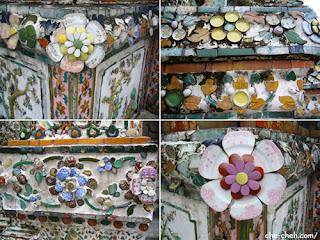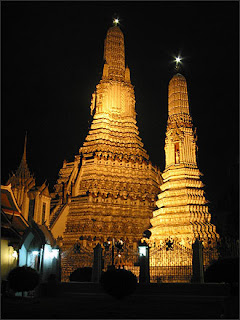It is located close to the Charoenpart Bridge on Isaraphap road in Thonburi. The temple dated from the Ayutthaya Period and it was called originally Wat Phrab. King Rama I ordered the construction of a new temple next to Wat Phrab and the two temples were combined as one. In 1808 the temple was again renovated.
December 12, 2007
Wat Rajasittharam Rajaworawihara ( Wat Rajasit)
It is located close to the Charoenpart Bridge on Isaraphap road in Thonburi. The temple dated from the Ayutthaya Period and it was called originally Wat Phrab. King Rama I ordered the construction of a new temple next to Wat Phrab and the two temples were combined as one. In 1808 the temple was again renovated.
ป้ายกำกับ: Wat Rajasit
เขียนโดย neungkrdoll ที่ 8:55 AM 0 ความคิดเห็น
December 8, 2007
Wat Rajapradit Sathitmahasimaram Rajaworavihara (Wat Rajapradit)
ป้ายกำกับ: Wat Rajapradit
เขียนโดย neungkrdoll ที่ 2:58 PM 0 ความคิดเห็น
December 7, 2007
Wat Boromniwas ( Wat Borom )
Of importance is the Phra Tosapholayarn, a Buddha image in the marn vichai pose that is installed as the presiding image in the phra ubosot. In the phra ubosot there are unusual murals that were painted by Khrua In Khong, the leading artist of the reign, depicting landscapes and people drawn in the Western style, similar to those found at Wat Bowornniwet Vihara. Between the windows there are scenes depicting activities of Buddhist laymen and monk, such as the ordination ceremony, presentation of robes for the monkhood, observing the precepts during Buddhist Lent, the Loy Krathong festival, Kathina robe presentation and offer picked-up robed, and making merit on the feasts of Magha Puja and Visakha Puja. Above the windows there are scenes in which the people are all Europeans and include scenes of a train and stargazing with a telescope.Also of interest are the monks' residences and the entrance arch, which are in the European style, the work of craftsmen in the reign of King Rama V.
ป้ายกำกับ: Wat Borom
เขียนโดย neungkrdoll ที่ 7:50 AM 0 ความคิดเห็น
WAt Benjamabopit Dusitwanaram (Wat Ben)
The name Marble Temple derives from the phra ubosot , which is square and completely covered with white marble . In it is enshrined a reproduction of the Phra Buddhachinarat image, which King Rama V had copied from the original in Phitsanulok Province.
ป้ายกำกับ: Wat Benjamabopit
เขียนโดย neungkrdoll ที่ 4:33 AM 0 ความคิดเห็น
Wat Arun (Temple of Dawn)
During the Bangkok Period, the temple has been renovated and extended, and it was given its present name by King Rama IV.
ป้ายกำกับ: Wat Arun
เขียนโดย neungkrdoll ที่ 3:59 AM 0 ความคิดเห็น
December 5, 2007
Wat Dusidaram Woravihara ( Wat Dusid )
ป้ายกำกับ: Wat Dusid
เขียนโดย neungkrdoll ที่ 2:58 PM 0 ความคิดเห็น
Wat Anong
ป้ายกำกับ: Wat Anong
เขียนโดย neungkrdoll ที่ 2:58 PM 0 ความคิดเห็น
Grand Palace and Wat Phra Kaew
ป้ายกำกับ: Grand Palace and Wat Phra Kaew
เขียนโดย neungkrdoll ที่ 2:58 PM 0 ความคิดเห็น
Wat Intharavihara ( Wat In )
 Located on Visut Kasat Road, near Bang Khun Phrom Intersection opposite the Bank of Thailand . The temple was built before the founding of the capital and was originally called Wat Bang Khun Phrom Nok. It was renovated and renamed Wat Intharam when King Rama I provided land in Bang khun Phrom Sub-district for the settlement of prisoners of war from Vientiane. Chao In, an uncle of Chao Noi Khiew Khom, one of the King's chief wives, renovated the temple and invited Chao Khun Phra Aranyik, a monk who had also come from Vientiane, to preside as an abbot. Chao Inthawong , the son ofSomdej Phra Boworn Rajchao Mahasakdipholasep, was responsible for a second renovation.
Located on Visut Kasat Road, near Bang Khun Phrom Intersection opposite the Bank of Thailand . The temple was built before the founding of the capital and was originally called Wat Bang Khun Phrom Nok. It was renovated and renamed Wat Intharam when King Rama I provided land in Bang khun Phrom Sub-district for the settlement of prisoners of war from Vientiane. Chao In, an uncle of Chao Noi Khiew Khom, one of the King's chief wives, renovated the temple and invited Chao Khun Phra Aranyik, a monk who had also come from Vientiane, to preside as an abbot. Chao Inthawong , the son ofSomdej Phra Boworn Rajchao Mahasakdipholasep, was responsible for a second renovation.Chao Khun Phra Aranyik was an expert in meditation and had once been the instructor of Somdej Phra Buddhacharn ( To ) of Wat Rakhangkhositaram, who initiated the construction of Luang Pho To, a large standing Buddha image. The construction of the image had reached only to the navel when Somdej Phra Buddhacharn died. It was completed in the reign of King Rama VII.
ป้ายกำกับ: Wat In
เขียนโดย neungkrdoll ที่ 2:58 PM 0 ความคิดเห็น
Wat Chinorasaram Woravihara ( Wat Chinoros )
King Rama IV ordered the artisans to sculpt and draw pictures of the naga, or mythical serpent, in many places as a reminder of the prince's former name, which was , Prince Wasukri. He also had a crown sculpted that was placed above the frame behind the presiding Buddha image in the phra ubosot.
The phra ubosot of Wat Chinorasaram Woravihara displays artistic styles of the Third Reign. Decorative roof tiles, the chofa, bai raka gable apex ornaments, the gable decorated with plaster plants and flowers and half figures a deity with folded hands in the center, and decorated with gold leaf on pieces of glass. The door and window frames bear kanok designs in gilded plaster studded with glass. The interior door and window panels are decorated with haw or toh chin, patterns. The exteriors are decorated with lai rod nam pattern with nagas flying in the clouds. The exterior of the central door depicts Siew kang holding a fan and treading on a naga. The ceiling is painted red and decorated with naga fretwork and covered with gold leaf.
ป้ายกำกับ: Wat Chinoros
เขียนโดย neungkrdoll ที่ 2:58 PM 0 ความคิดเห็น
Wat Chakkrawadrajawas Woramahavihara (Wat Sam Pleum)
In approximately 1819, Chao Phraya Bodin Decha (Sing Singhaseni) , the leading general in the reign of King Rama III, began rebuilding the temple. Upon completion he presented the temple to King Rama III as a royal temple and it was given the name that is bears to this day. The temple has many interesting structures such as the large phra prang, the Mondop Phra Buddhabat, the crocodile pond, and Khao Phra Buddha Chai.
The phra vihara once housed the Phra Bang, an important Buddha image that was brought from Vientiane. At present this image resides in Luang Prabang, Laos, King IV having returned it to Laos in 1866.Besides the usual buildings that are found in a temple such as the phra ubosot, the phra vihara, of which there are three, the tripitaka tower, and the Mondop Phra Buddhabat, there is also a shrine houses a statue of Chao Phraya Bodin Decha. In front of and slightly to one side of the phra ubosot there is a pond where crocodiles were kept, the origin of the expression the "crocodiles of Wat Sam Pleum".
ป้ายกำกับ: Wat Sam Pleum
เขียนโดย neungkrdoll ที่ 2:58 PM 0 ความคิดเห็น
Wat Phrachetuphon Wimonmangkhalaram Rajaworamahavihara ( Wat Pho)
It is situated behind the Grand Palace, near the Tha Tien Pier. It is a large temple originally called Wat Photharam, that was built during the Ayutthaya Period. King Rama I ordered its complete restoration in 1789 and installed many Buddha images that were removed from abandoned temples in other parts of the country.
The Phra Buddhasaiyat, or Giant Reclining Buddha, in the phra vihara for which the temple is famed was constructed in the Third Reign. On the sole of the foot inlaid in mother of pearl is the auspicious number 108.
ป้ายกำกับ: Wat Pho
เขียนโดย neungkrdoll ที่ 2:58 PM 0 ความคิดเห็น

















































